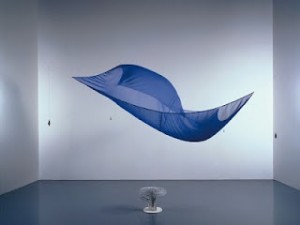Parents are always telling their children that people cannot make a living doing art. However, that didn’t stop Hans Haacke as he created his way to success. The College welcomed this crafty German artist to the Education Building on Monday, Feb. 24, as part of the Visiting Artist Series.

Known for unique ways of exploring natural and social processes in his art, he treated the audience to a “show and tell” of some of his favorite pieces.
He began by presenting “Blue Sail,” a picture consisting of a blue chiffon sheet being blown up in the air by a fan. What seemed like a simple picture bedazzled the audience. He also showed his work titled “The Invisible Hand of the Market,” which stressed the importance of the concept of industry.
Haacke continued with a photograph of a 3-year-old boy wearing a T-shirt with the word “Paradise” on it. Originally, the photo was aimed at portraying the boy, but he later decided to make the boy’s T-shirt the center of the photo.
He showed another photograph of a rainbow that he had taken. In the background, there was a construction crane. At first, Haacke was bothered by the crane in the back of the picture and wanted to wipe it out digitally, but he decided to keep it and grew to love the photograph.
Likewise, Haacke also presented pictures with a collage effect. He combined everyone’s favorite donut-eating cartoon
character, Homer Simpson, into a portrait of “The Last Supper.”
He even showed photos of people looking at art and photos of colorful lego and puzzle pieces sprawled across the ground.
Haacke strived to create art that was more than pleasing to the eyes, but was also pleasing to the mind. He wanted to teach lessons in his work.
He further explained to the audience that some of his work was censored in museums, which shocked him. He never
considered his work to be objectionable.
He even revealed how the curator of a museum was fired when he stood up for Haacke’s work.
Overall, it was a very creative and artsy night.
In remarks to the presentation, senior philosophy major Stephanie Chou said, “He does an amazing job of putting what
is available to us in context, and he never implicates what should or should not be done.”






